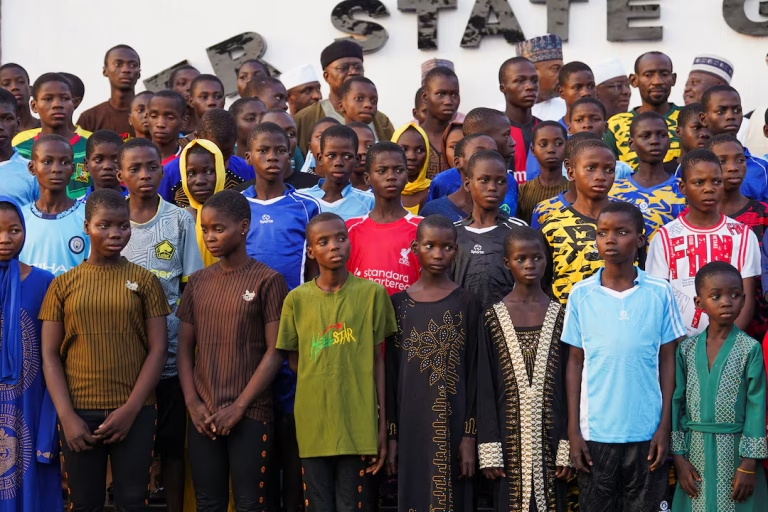Hope and relief returned to Niger State on Monday as 100 children abducted from St. Mary’s Private Catholic Primary and Secondary School in Papiri, Agwara Local Government Area, regained their freedom nearly three weeks after being kidnapped by armed bandits.
The school was attacked on November 21, 2025, in one of the latest mass abductions targeting educational institutions in northern Nigeria. A total of 315 students, pupils, and staff were initially seized during the night raid. About 50 escaped earlier, leaving over 260 in captivity.
Local media confirmed the children’s safe return late Sunday, and by Monday evening, they were received in Minna by Niger State Governor Mohammed Umar Bago during an emotional ceremony attended by security officials, clergy, parents, and representatives of international organisations.
At exactly 5:30 p.m., the thin and visibly exhausted children — aged between five and ten — arrived in a convoy of military vehicles and marched into the Government House hall to thunderous applause. Some cried tears of relief while others clung tightly to caregivers.
Governor Bago, visibly moved by their condition, expressed gratitude to security agencies and President Bola Ahmed Tinubu for supporting rescue efforts.
“We want to thank Mr President for giving us the necessary inputs to rescue these children,” the governor said with a shaky voice. “We are emotionally broken seeing their sizes and their ages… but this joy gives us strength to continue. By the grace of God, in a very short time, we will recover the remaining children, Insha Allah.”
The governor also assured parents that medical teams had been mobilised to provide urgent care before the children are reunited with their families.
Handing over the children to state authorities, a representative of the National Security Adviser, Abdullahi Hong, reiterated the government’s commitment to securing the release of those still in captivity.
President Tinubu, in a statement issued by his media aide Bayo Onanuga, welcomed the development and vowed that no victim would be left behind.
“My directive remains that all the students and other abducted Nigerians must be rescued and brought back home safely,” the President stated. “From now on, our security agencies, working with the governors, must prevent future kidnappings. Our children should no longer be sitting ducks for heartless terrorists.”
Church leaders in Niger State also joined in thanksgiving while urging intensified rescue operations. The Christian Association of Nigeria (CAN), which runs the school, recently concluded a three-day statewide prayer and fasting for the safe return of the abductees.
“It will be a thing of joy if some of our children have been released,” said Bishop Bulus Yohanna of Kontagora Diocese, through his spokesperson Daniel Atori. “We have been praying and waiting for their return. If it is confirmed, then it is cheering news. However, until all our children are back, we will not rest.”
Despite the celebration, concerns remain for the 115 students and 12 staff members believed to still be held by the kidnappers. It also remains unclear whether their release was secured through negotiation, a military operation, or ransom — a practice banned by Nigerian authorities but widely believed to continue underground.
The attack on St. Mary’s adds to a troubling wave of kidnappings sweeping schools, churches, and rural communities across northern and central Nigeria. Analysts say criminal gangs, driven by profit, fuel an abduction industry that netted over $1.6 million between July 2024 and June 2025, according to research by SBM Intelligence.
As families reunite with their children in Papiri in the coming days, local communities remain gripped by fear and uncertainty.














